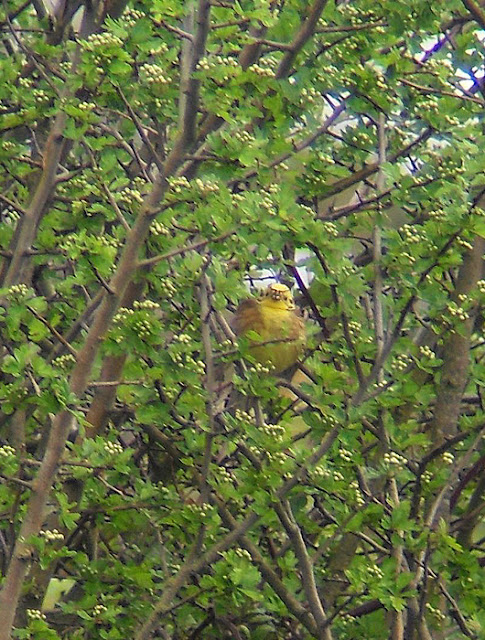A two centre trip today, starting with Five Oak Lane – a hidden-away area of scrub and grassland adjacent to Hainault Golf Club and then a short trip south east to Rainham Marshes in Essex beside the Thames.
Five Oaks Lane is a hidden gem. I love it best for the almost guaranteed Cuckoos and Yellowhammers you will find here at this time. With heavy, leaden skies making it very dark and some seriously waterlogged paths making it foolhardy not to keep looking downat where you walked, looking for these birds was slightly hindered. A pair of Bullfinches made it easy as they barrel-rolled past my head with the unmistakeable white rump flash easing identification.
Then that unique call of the Yellowhammer could be heard. 'A-little-bit-of-bread-and-no-cheeeeeeese' is what it sounds like but finding the yellow devil was less simple. Some careful scanning of the hawthorn bushes produced a fine male bird. Normally there are around ten birds at this site but this one was the only one I saw in my hour long stay.
 |
| Yellowhammer playing hide and seek. |
Next up the classic cuckoo call came from the near distance and before long, two males flew close together and low over the open scrubland. In a small pocket of woodland,
Great Spotted Woodpeckers,
Jays and
Blackcaps were very active. Next stop Rainham.
Again, the skies at Rainham Marshes were dark. But not just because of the threatening rain clouds. The sky was full of
Common Swifts. They were buzzing just over my head and I have never experienced these birds at such close quarters; I felt sure I could catch one in my hand they were that close.
 |
| Common Swift. The other 100 were caught up in my hair. |
Along the Thames shoreline, there were lots of waders. The fresh northerly wind had obviously persuaded them to come down and have a break.
Dunlins, Grey Plovers and a few
Whimbrel fed close to the incoming tide.
 |
| Whimbrel and Grey Plovers |
A little further on, a party of godwits, a mixture of
Bar-tailed Godwits and
Black-tailed Godwits also probed about in the mud for sustenance.
 |
| Bar-tailed Godwits |
While scanning the waders, a bird caught my attention from the corner of my eye. I was positioned close to a tall wire fence and sitting atop of this fence was a male
Wheatear. I had missed the chance of getting a shot of one of these confiding birds only day ago and I wasn’t going to miss out again.
Wheatears are predictable. You can’t really creep up on them to get a shot, you have to work out their habits or favourite perching posts are and just wait. Eventually, they will return to allow you decent shooting opportunities like these:
 |
| Female Wheatear |
 |
| Male Wheatear |
At the end of the river path, close to the small car park, there were a couple of
Lesser Whitethroats. One day I will get images of these skulking warblers.
On to the reserve itself. There were at least 15
Yellow Wagtails at the first hide.
House Martins,
Swallows and
Swifts skimmed the water surface while a pair of
Lapwings kept a close eye on a single chick that looked ambitiously at the water with a view of stepping on it. Towards the back a pair of
Avocets came in to add a bit of event branding for the RSPB reserve here.
 |
| Avocets |
With the weather now turning with an irritating rain messing with my optics, I holed up in one of the hides. There wasn’t much to be seen but a
Little Grebe and a
Sedge Warbler kept the crowd entertained. I was really impressed with the younger members in the hide who spotted Yellow Wagtails and marvelled at the
Pied Wagtail that displayed right in front of us. the hide walls are covered in kids paintings and drawing of birds and nature that make you realise how important the work the RSPB do to educate people from an early age, the importance of conservation and the enjoyment we all get from it.
 |
| Sedge Warbler |











Comments
Post a Comment